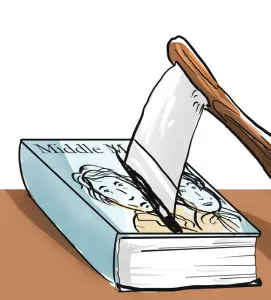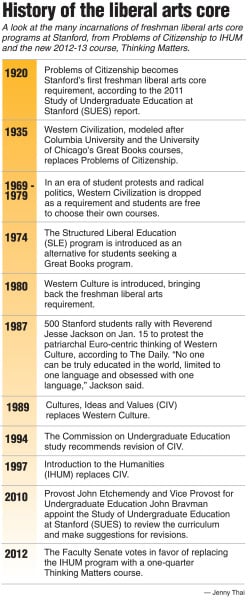The Faculty Senate closed the book on the Introduction to the Humanities (IHUM) program by voting on March 8 in favor of replacing the program with a one-quarter “Thinking Matters” course, scheduled to launch this coming fall. Although IHUM was a quintessential fixture of the Stanford experience for recent students, it was only the latest edition in Stanford’s history of freshman liberal arts programs, an undergraduate tradition that is nearly 90 years old.

Pioneering liberal arts
For the first three decades following the University’s founding in 1891, there was no freshman liberal arts core program in place. In 1920, a yearlong course, The Problems of Citizenship, became a requirement for all freshmen.
Partly influenced by the passage of the 19th Amendment, The Problems of Citizenship course endeavored to teach students the necessary skills to become informed citizens cognizant of their political environments. Topics on the syllabus included Citizenship in a Democratic World and Scientific Method and Attitude. In addition to weekly lectures taught by faculty from various departments, students also had one-on-one sessions with the instructors.
The Problem of Citizenship program lasted until 1934, when dwindling student interest and shaky faculty support led to its termination.
The golden age of the Great Books
Unlike its predecessor, The History of Western Civilization program (Western Civ) , launched in 1935, was taught only by the History Department. Based on the Great Books programs of Columbia University and the University of Chicago, Western Civ was a single-track, three-quarter course that used a core list of fifteen “Great Books” to trace the development of European thought from the classical age to modernity. The course reflected a trend in American universities to rediscover European roots and affirm new prominence in global politics after the chaotic confusion and loss of identity during the decades following World War I.
Western Civ was an immensely well-received program and lasted well into the 1960s. Although the course was antiquated in the sense that its reading list was composed of works by white European males, many alumni have cited the program as one of the best academic experiences they had at Stanford.
“It helped me become a historian,” said John Reider, ’67 Ph.D. ’83, former senior associate director of admission at Stanford and former Structured Liberal Education (SLE) director. “Many people of my ancient era look back on the course with great fondness.”
Challenging western thought: a humanities free-for-all
Swept up by the volatile political atmosphere that propelled campus disturbances in the latter half of the 1960s, Western Civ, along with many other liberal arts program requirements at other American universities, succumbed to the pressure of protesting students and faculty who condemned the antiquated rigidity of a structured liberal arts program. The dominating rationale was that students could only flourish if they were free from the constraints of specific requirements.
“The reigning idea among Stanford students was that everything was equal and students should determine what they needed to know,” Reider said. “The world was their oyster. The faculty was very happy with that because they could teach what they wanted to teach.”
Beginning in 1969, there was no liberal arts requirement to bind Stanford students. Where course selection outside their majors of study was concerned, students were given only a loose set of requirements and mostly left to their own devices on how to complete them.
A return to structure: from Western Culture to a different CIV
In the middle of the ’70s, it became clear to Stanford faculty that the courses students chose outside of their major disciplines were more than often haphazard and collectively lacked unity. In an attempt to remedy the situation by establishing a new set of liberal arts requirements, a new Western Culture requirement was introduced. Western Culture was a course that aimed to renew the University’s commitment to Western intellectual thought and tradition.
While the material in Western Culture shared many similarities with Western Civ, what set Western Culture apart from its predecessor was its multiple-emphases structure, a compromise between the single-track nature of Western Civ and the total absence of tracks in the ’70s. Western Culture included eight different tracks created by different departments to cater to a diversity of student intellectual interests. While tracks such as Literature and Arts stuck more closely to European intellectual tradition, other tracks such as Values, Technology, Science and Society offered reading material that emphasized the role of technology and science, which appealed to the engineering-inclined.
Given the choice to select from a set of academic tracks, Western Culture initially showed promise for success. Yet the course was crippled by the program’s lack of a coherent reading list. Although each individual track had its own tailored reading list, in an effort to maintain the semblance of a common reading experience, the Western Culture program required all tracks to also follow a list of core texts. The imposition of a core reading list proved difficult as many tracks, particularly the Values, Technology, and Science track, could not coherently incorporate the core texts into the lessons.
At the same time, the student population experienced a demographic shift resulting in an increased presence of minority groups, including African-American, Asian and Latino students.
Disturbed by the Euro-centric nature of the tracks, the Black Student Union, later joined by campus feminists and other minority groups, spoke out against racism and sexism in the Western Culture curriculum.
“The Western culture program as it is presently structured around a core list and an outdated philosophy of the West being Greece, Europe, and Euro-America is wrong,” said Bill King, chairman of the Black Student Union in his 1988 address to the Faculty Senate. “And worse, it hurts people mentally and emotionally in ways that are not even recognized.”
Western Culture was replaced by Culture, Ideas and Values (CIV). While retaining the multi-track structure of Western Culture, the CIV track reading lists were diversified to include representative works from women and ethnic minorities alongside some traditional readings. More importantly, the core reading list binding all tracks together was dropped.
The birth of IHUM
Surprisingly, CIV, in comparison to its predecessors, was a relatively short-lived program. The Commission on Undergraduate Education study in 1994 revealed that many students found that the tracks were too diverse — not only in content, but also in workload and grading policy. Professors also felt that there were too many books to cover in a single year.
Introduction to the Humanities (IHUM) gradually replaced CIV in the late 1990s, the University’s tonic to clarify the CIV curriculum. The number of books designated for each track was reduced and tracks were modified to center around the universality of ideas. According to the IHUM website, IHUM courses dealt with the “issues, themes, ideas and values of human identity and existence,” rather than following a traditional canon.
SLE, the “Great Books” haven
While the main freshman liberal arts sequences have cycled through several incarnations, one residentially based program for freshmen has endured the test of time. Unlike IHUM and its predecessors, the Structured Liberal Education (SLE) program has remained largely unchanged since its founding. SLE developed from an evening seminar series titled “Social Thoughts and Institutions,” in which professors and students from various departments, as equals, read and discussed Great Books.
SLE became a fully-fledged residential program in 1974. With only minor modifications to its Great Books reading list, SLE’s Great Books approach has been rated consistently high in student evaluations. The self-selecting nature of SLE, which freshmen opt into in place of IHUM, is one of the main contributors to the program’s enduring success.
“It’s very simple — they were voluntary,” Reider said. “They wanted to be there.”
Thinking Matters and diversification of the humanities
Although the findings of the 2011 Study of Undergraduate Education at Stanford (SUES) on the lukewarm student enthusiasm toward the IHUM program may be a recent development, the student voices speaking out against the constraint of requirements echo the spirit of the ’60s, when pressure from students to direct their own liberal arts experiences was the strongest.
Thinking Matters, a one-quarter course slated to replace the three-quarter IHUM program starting in the academic year 2012-2013, came from a SUES recommendation to increase the freedom freshmen, particularly those enrolled in major programs with high unit requirements, will have to explore courses outside their major fields of study.
Thinking Matters will also break from the traditional mold of humanities instruction with its development of innovative course themes. Proposed topics include Brain, Behavior and Evolution; Energy; Evil; and The Physics of One. Many of these courses will draw upon a diverse variety of disciplines, including those not traditionally studied alongside the humanities.
As reported by The Daily in March, the Faculty Senate approved the Committee on Undergraduate Standards and Policy (C-USP) report supporting the SUES recommendation on March 8.
Given the speed with which the Faculty Senate approved Thinking Matters — only two months after the SUES recommendation — some faculty are skeptical of the success of the proposed course, or view the amorphous, multi-disciplinary suggested course topics as a sign of the atrophying presence of the humanities at Stanford.
“It wasn’t really that broken,” said Greg Watkins, assistant director of SLE. “The evaluations of IHUM from students were quite favorable, more favorable than student reputation. What the University has caved into is the demand for choice.”
“Not that there’s something wrong with that but students were feeling the yoke of that requirement,” Watkins added. “I feel that it’s like giving up on taking responsibility for teaching in the humanities and requiring our students a certain level of education.”
Other faculty members however are more optimistic, seeing Thinking Matters as a means of reviving declining student interest in the humanities.
“I think it’s plausible for us to speculate that the humanities in the future will no longer be a burdensome requirement that everyone has to go through but it will be one among many different opportunities,” said Russell Berman, director of the IHUM and Introductory Seminars programs. “I say that if we are concerned that students will no longer take humanities, we should just be more imaginative in the kind of humanities courses that we offer.”

